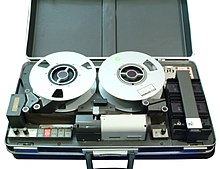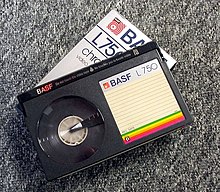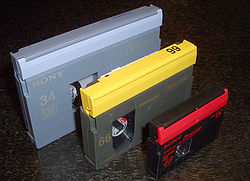rom Wikipedia, the free encyclopedia
"VCR" redirects here. For other uses, see VCR (
| | This article's introduction section may not adequately summarize its contents. To comply with Wikipedia's lead section guidelines, please consider expanding the lead to provide an accessible overview of the article's key points. (May 2010) |

All video tape recorders are not videocassette recorders. The early models of VTRs were reel-to-reel devices that required hand-threading of the tape. (This is the first portable video recorder, the 1967 Ampex quadruplex.)
A VCR is different from a video tape recorder in that VTRs can also be reel-to-reel devices that require hand-threading of the tape from a single supply reel, through the recording mechanism and onto a separate take-up reel. VCRs tend to be lower maintenance than reel-to-reel VTRs, since the tape path is usually fully enclosed to keep dust out of the mechanism, and the tape is almost never touched by the user except when malfunctions occur.
Most VCRs have their own tuner (for direct TV reception) and a programmable timer (for unattended recording of a certain channel at a particular time). These began as simple mechanical counter-based features similar to those available on contemporary audio equipment, but quickly turned into major selling and differentiation points, with multiple programs possible through a menu interface that used the TV as a display.
[edit] History
[edit] Early machines and formats
The history of the videocassette recorder follows the history of videotape recording in general. Ampex introduced the Ampex VRX-1000, the first commercially successful videotape recorder, in 1956. It used the 2" Quadruplex format, using two-inch (5.1 cm) tape.[1] Due to its US$50,000 price, the Ampex VRX-1000 could be afforded only by the television networks and the largest individual stations.[2]In 1963, Philips introduced their EL3400 1" helical scan recorder (aimed at the business and domestic user) and Sony marketed the 2" PV-100, their first reel-to-reel VTR intended for business, medical, airline, and educational use.[3]
[edit] First home video recorders
The Telcan, produced by the Nottingham Electronic Valve Company in 1963, was the first home video recorder. It could be bought as a unit or in kit form for £60. However, there were several drawbacks: it was expensive, not easy to put together and it could only record 20 minutes output at a time in black-and-white.[4][5][6]The Sony model CV-2000, first marketed in 1965, was their first VTR intended for home use and was based on half inch tape.[7] Ampex and RCA followed in 1965 with their own reel-to-reel monochrome VTRs priced under US $1,000 for the home consumer market.
The EIAJ format was a standard half-inch format used by various manufacturers. EIAJ-1 was an open reel format. EIAJ-2 used a cartridge that contained a supply reel, but not the take-up reel. As the take-up reel was part of the recorder, the tape had to be fully rewound before removing the cartridge, a slow procedure.
The development of the videocassette followed the replacement by cassette of other open reel systems in consumer items: the Stereo-Pak 4-track audio cartridge in 1962, the compact audio cassette and Instamatic film cartridge in 1963, the 8-track cartridge in 1965, and the Super 8 home movie cartridge in 1966.
[edit] Sony U-matic
Main article: U-matic
Sony demonstrated a videocassette prototype in October 1969, then set it aside to work out an industry standard by March 1970 with seven fellow manufacturers. The result, the Sony U-matic system, introduced in Tokyo in September 1971, was the world's first commercial videocassette format. Its cartridges, resembling larger versions of the later VHS cassettes, used 3/4-inch (1.9 cm) tape and had a maximum playing time of 60 minutes, later extended to 90 minutes. Sony also introduced two machines (the VP-1100 videocassette player and the VO-1700 videocassette recorder) to use the new tapes. U-matic, with its ease of use, quickly made other consumer videotape systems obsolete in Japan and North America, where U-matic VCRs were widely used by television newsrooms, schools and businesses. But the cost—US$1,395 for a combination TV/VCR, or $7,069 in 2007 dollars—kept it out of most homes.[8][edit] Philips "VCR" format
Main article: Video Cassette Recording
In 1970 Philips developed a home videocassette format. Confusingly, Philips named this format "VCR" (although it is also referred to as "N1500", after the first recorder's model number). The format was also supported by Grundig and Loewe. It used square cassettes and half-inch (1.3 cm) tape, mounted on co-axial reels, giving a recording time of one hour. The first model, available in the United Kingdom in 1972, was equipped with a crude timer that used rotary dials. At nearly £600 ($2087), it was expensive and the format was relatively unsuccessful in the home market. This was followed by digital timer version in 1975, the N1502. In 1977 a new (and incompatible) long-play version ("VCR-LP") or N1700, which could use the same tapes, sold quite well to schools and colleges.[edit] Avco Cartrivision
Main article: Cartrivision
The Avco Cartrivision system, a combination television set and VCR from Cartridge Television Inc. that sold for US $1,350, was the first videocassette recorder to have pre-recorded tapes of popular movies available for rent. Like Philips' VCR format, the square Cartrivision cassette had the two reels of half-inch tape mounted on top of each other, but it could record up to 114 minutes. It did so using a crude form of video compression that recorded only every third video field and played it back three times. Cassettes of major movies such as The Bridge on the River Kwai and Guess Who's Coming to Dinner were ordered via catalog at a retailer, delivered by parcel mail, and then returned to the retailer after viewing. Other cassettes on sports, travel, art, and how-to topics were available for purchase. An optional monochrome camera could be bought to make home videos. Cartrivision was first sold in June 1972, mainly through Sears, Macy's, and Montgomery Ward department stores in the United States. It was abandoned thirteen months later after poor sales.[edit] The late 1970s: Mass-market success
It was not until the late 1970s, when European and Japanese companies developed more technically advanced machines with more accurate electronic timers and greater tape duration, that the VCR started to become a mass market consumer product. By 1979 there were three competing technical standards, with different, physically incompatible tape cassettes.[edit] VHS vs. Betamax
Main article: Videotape format war
The two major standards were Sony's Betamax (also known as Betacord or just Beta), and JVC's VHS [Video Home System], which battled for sales in what has become known as the original and definitive format war.Betamax was first to market in November 1975, and was argued by many to be technically more sophisticated,[9] although many users did not perceive a difference. The first machines required an external timer, and could only record one hour. The timer was later incorporated within the machine as a standard feature.
The rival VHS format, introduced in Japan in September 1976 (and introduced in the United States in July 1977 by JVC) boasted a longer two-hour recording time, with four hours using a "long play" mode (RCA SelectaVision models, introduced in September 1977). Because 2 hours and 4 hours was near-ideal for recording movies and sports-games respectively, the consumer naturally flocked towards VHS rather than the 1-hour-limited Betamax. Although Sony later introduced Beta-II and Beta-III to allow a maximum time of 5+ hours, by that time VHS was already boasting 6, 8, or even 9 hours per tape. Thus VHS had a perceived "better value" in the eye of the consumer during the late 1970s.[citation needed]
[edit] Philips Video 2000
Main article: Video 2000
A third format, Video 2000, or V2000 (also marketed as "Video Compact Cassette") was developed and introduced by Philips in 1978, and was sold only in Europe. Grundig developed and marketed their own models based on the V2000 format. Most V2000 models featured piezoelectric head positioning to dynamically adjust the tape tracking. V2000 cassettes had two sides, and like the audio cassette had to be flipped over halfway through their recording time. User switchable record protect levers were used instead of the breakable lugs found on VHS/Beta cassettes. The half-inch tape used contained two parallel quarter-inch tracks, one for each side. It had a recording time of 4 hours per side, later extended to 8 hours per side on a few models. V2000 hit the market after its two rivals in early 1979. The last models produced by Philips in 1985 were felt by many to be superior machines to anything else on the market at the time but the poor reputation gained through the limited features and poor reliability of early models, and the by now dominant market share of VHS/Betamax, ensured only limited sales before the system was scrapped shortly after.[edit] Other early formats
Some less successful consumer videocassette formats include:- V-Cord, launched by Sanyo in 1974
- VX, launched by Panasonic in 1975
- Compact Video Cassette (CVC), developed by Funai and Technicolor and introduced in 1980.
[edit] The court battle
In the early 1980s, the film companies in the USA fought to suppress the device in the consumer market, citing concerns about copyright violations. In Congressional hearings, Motion Picture Association of America head Jack Valenti decried the "savagery and the ravages of this machine" and likened its effect on the film industry and the American public to the Boston strangler:In the case Sony Corp. of America v. Universal City Studios, Inc., the Supreme Court of the United States ruled that the device was allowable for private use, thereby guaranteeing market acceptance. In the years following, the film companies found that videorecordings of their products had become a major income source.We are going to bleed and bleed and hemorrhage, unless this Congress at least protects one industry that is able to retrieve a surplus balance of trade and whose total future depends on its protection from the savagery and the ravages of this machine. ... I say to you that the VCR is to the American film producer and the American public as the Boston strangler is to the woman home alone.—Hearings before the Subcommittee on Courts, Civil Liberties and the Administration of Justice of the Committee of the Judiciary, House of Representatives, Ninety-seventh Congress, Second Session on H.R. 4783, H.R. 4794 H.R. 4808, H.R. 5250, H.R. 5488, and H.R. 5705, Serial No 97, Part I, Home Recording of Copyrighted Works, April 12, 1982. US Government Printing Office.[10]
[edit] Product Flaws
The Video Cassette Recorder is known to have glitches and common bugs. Reviews state that people experience the magnetic tape of the VHS to be 'chewed' or 'eaten' when ejected from the machine due to a lack of cleaning, or old age, and therefore the VHS tape becomes unusable. VHS tapes recorded in LP or EP/SLP mode tend to not play back very well on other machines, and tapes recorded on a machine made before 1995 tend to not play well on newer machines. Newer VCRs tend to have a shorter lifespan than older units, and are built with cheaper designs and parts, resulting in new machines not having many buttons on the unit, such as tape speed, display, seconds counter, tracking, audio monitor, etc. and relying more on the remote and automatic features.[edit] Decline

A typical VCR toward the end of its popularity. After decades of refinement in design and production, models similar to this were available for under US$50
Because of lack of sales, most manufacturers slowly reduced their VCR lineups to only basic consumer models (phasing out professional models and S-VHS models) or stopped production completely.
The declining market combined with a Federal Communications Commission mandate effective March 1, 2007, that all new TV tuners be ATSC tuners have encouraged major electronics makers, including Funai, JVC, and Panasonic, to end production of standalone units for the U.S. market. To avoid this costly mandate, most new standalone VCRs in the U.S. today can only record from external baseband sources (usually composite video), including CECBs which (by NTIA mandate) all have composite outputs, as well as those ATSC tuners (including TVs) & cable boxes that come with composite outputs. Netflix, the leading online video rental service in the United States, does not offer VHS tapes.
The new high definition optical disc format Blu-ray Disc may gradually replace the DVD format. Some analysts[who?] expect this change to take place like the VHS to DVD transition. However, with many homes still having a large supply of VHS tapes and with all Blu-ray players designed to play regular DVD's and CD's by default, some manufacturers are now making VCR/Blu-ray combo players.[12]
[edit] Special features
[edit] Multi Standard
One of the problems faced with the use of video recorders was especially the exchange of recordings between PAL and NTSC countries. Multi Standard video recorders and TV sets gradually overcame these incompatibility problems.[edit] Stereo Sound & HiFi
The U-matic machines were always made with Stereo, and Beta and VHS started out splitting the audio track on the tape, but the slow tape speed of Beta and VHS limited the sound quality. So HiFi was introduced where they modulated the Left and Right sound tracks as FM on the video portion of the tape.The 8 mm format always used the video portion of the tape for sound, with an FM carrier between the band space of the chrominance and luminance on the tape. 8 mm could be upgraded to Stereo, by adding an extra FM signal for Stereo difference.
[edit] Copy protection
See also: Copy protection
Introduced in 1983, Macrovision is a system that reduces the quality of recordings made from commercial video tapes, DVDs and pay-per-view broadcasts by adding random peaks of luminance to the video signal during vertical blanking. These confuse the automatic level adjustment of the recording VCR which causes the brightness of the picture to constantly change, rendering the recording unwatchable.When creating a copy-protected videocassette, the Macrovision-distorted signal is stored on the tape itself by special recording equipment. By contrast, on DVDs there is just a marker asking the player to produce such a distortion during playback. All standard DVD players include this protection and obey the marker, though unofficially many models can be modified or adjusted to disable it.
Also, the Macrovision protection system may fail to work on older VCR's made before 1986 and some high end decks built afterwords, usually due to the lack of an AGC system. Newer VHS and S-VHS machines (and DVD recorders) are susceptible to this signal; generally, machines of other tape formats are unaffected, such as all 3 Betamax variants. VCRs designated for "professional" usage typically have an adjustable AGC system, a specific "Macrovision removing" circuit, or Digital Timebase Corrector and can thus copy protected tapes with or without preserving the protection. Such VCRs are usually overpriced and sold exclusively to certified professionals (video editors, TV stations etc.) via controlled distribution channels in order to prevent their being used by the general public (however, said professional VCRs can be purchased reasonably by consumers on the second-hand/used market, depending on the VCR's condition). Nowadays, most DVDs still have copyright protection, but certain DVDs do not have it, usually pornography and bootlegs. However, some DVDs, such as certain DVD sets do not have the protection against VHS copying, possibly due to the VHS format no longer used as a major retail medium for movies.
[edit] Flying erase-heads
"Flying erase-heads" is an attribute of some VCRs to precisely edit video, usually performed by the aid of a frame buffer and a special interface to the VCR from a computer. The flying erase-head and the technique of using them was developed during a time when computers did not have sufficient memory for professional video editing applications.[edit] Variants




















